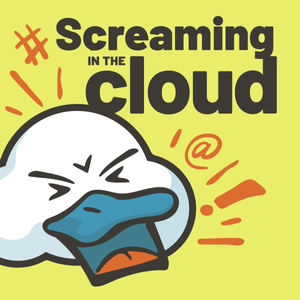
Screaming in the Cloud
Corey Quinn
All episodes
Best episodes
Top 10 Screaming in the Cloud Episodes
Goodpods has curated a list of the 10 best Screaming in the Cloud episodes, ranked by the number of listens and likes each episode have garnered from our listeners. If you are listening to Screaming in the Cloud for the first time, there's no better place to start than with one of these standout episodes. If you are a fan of the show, vote for your favorite Screaming in the Cloud episode by adding your comments to the episode page.
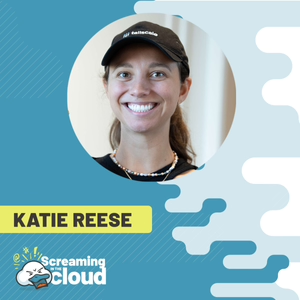
Behind The Tech Event Marketing Scene With Katie Reese
Screaming in the Cloud
04/18/24 • 32 min
This episode of Screaming in the Cloud features Katie Reese, an experienced events producer at Tailscale, who walks us through the ins and outs of event marketing within the tech industry. Katie shares insights on effective swag management and event planning to create memorable experiences that drive product adoption. Additionally, Katie and Corey discuss the challenges and strategies of marketing in a post-pandemic, budget-conscious world and explore how remote-first companies have adapted to these changes.
Show Highlights:
00:00 - Intro
00:19 - Welcome Katie Reese, discussing life in sunny Mexico City and her work at Tailscale
03:03 - How Tailscale's product-led growth feels like magic
05:08 - Success stories from the Tailscale Up conference
06:25 - Event strategies in the post-pandemic, budget-conscious era
09:04 - The benefits of remote-first companies and changes in the event landscape
10:36 - Katie's career journey and the value of networking at events
14:34 - The thoughtful approach to swag and reducing event waste
20:14 - How bad marketing can ruin customer interactions
25:40 - Ensuring swag runs out at the right time at conferences
28:10 - Discussion on ethical event practices and avoiding waste
32:04 - Closing thoughts and where to find Katie online
About Katie:
Katie leads field events at Tailscale and, when she is not traveling, splits her time between small-town Tennessee and Mexico City because it's all about balance.
Links referenced:
*Tailscale: https://tailscale.com/
*Katie's LinkedIn: https://www.linkedin.com/in/katie-reese/
*Katie’s Twitter: https://twitter.com/katiereese317?lang=en
Sponsor
*Panoptica Academy: https://panoptica.app/lastweekinaws

Episode 1: Feature Flags with Heidi Waterhouse of LaunchDarkly
Screaming in the Cloud
03/19/18 • 28 min
This podcast features people doing interesting work in the world of Cloud. What is the state of the technical world? Let’s first focus on the up or down, on or off function of feature flags.
Today, we’re talking to Heidi Waterhouse, a technical writer turned Developer Advocate at LaunchDarkly, which is a feature flag service - a way to wrap a snippet of code around your feature and make it into an instrument to turn on or off. It lets you turn things on and off in your codebase quickly without having to do several commits. However, it is difficult to track it when there are more than about a dozen flags. So, LaunchDarkly provides a way to manage your features at scale with a usable interface and API.
Some of the highlights of the show include:
- A feature flag allows you to hide items before you want them to go live on your Website. You hide it behind a feature flag, doing all the work ahead of time. Then, at some point, you turn it all on instantly without the risk of pushing untested code into your production.
- You can test at scale to gain authentic data. Test something with your team, your company’s employees, your customers, etc. However, no matter how good your integration tests are, there’s always wobbles to watch for in the system.
- With implementation, there are a few paths that can work, such as the massive reorganization path. Or, you can just start incrementally with feature flags for new features.
- LaunchDarkly thinks in the Cloud as the surface because it mostly works with people who are doing Web-based delivery of features.
- Major companies, like Google and Facebook, offer services similar to feature flags for their own development. They’re operating on such a giant scale that they have internal teams doing it.
- Companies use feature flags on the front-end and other purposes. It works through the whole stack from frontend page delivery, pricing tiers, white labeling, style sheets, to safer deployments.
- Do not focus on documentation. You should not have to read documentation for anything that you don’t own. Every feature should have documentation tied to its code. Create a customized experience.
- Feature flags effectively manage and minimize risk. There is always risk in the world, but what causes disaster is not just one failure. It is a multiplication of failures. This goes wrong and that goes wrong. Feature flagging breaks monolithic releases into tiny chunks that can go forward or backward.
- LaunchDarkly holds monthly meet-ups called, Test and Production. People share their use case regarding continuous integration, continuous deployment, DevOps, etc.
Links:
Quotes by Heidi:
“What feature flags do is make it possible for you to push out a deployment with things hidden, we call it launching darkly.”
“We’re all about avoiding risk, I think this is our motto this year, eliminate risk...you can’t eliminate risk, but you can make it much less risky.”
“Go ahead and write your feature. You know that it’s hidden behind the magical feature flying curtain until you’re ready to turn it on.”
“If 20 years of technical writing taught me anything, it’s that nobody wants to be reading documentation.”
.
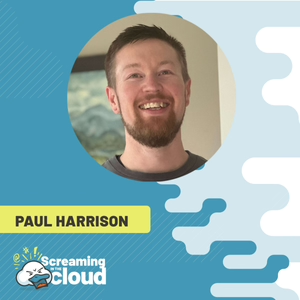
AI, Privacy, and User Control with Paul Harrison
Screaming in the Cloud
06/11/24 • 29 min
In this episode, Corey Quinn is joined by Senior Security Engineering Lead at Mattermost Paul Harrison in a discussion on the often-overlooked ethical implications of artificial intelligence in technology. They discuss how the rapid adoption of AI technologies might compromise user privacy and consent, reflecting on instances where companies may prioritize innovation at the expense of these core values. Their conversation highlights Mattermost's dedication to data privacy and user control, positioning the company as a privacy-centric alternative in the tech landscape.
Show Highlights:
(00:00) Introduction to the episode
(01:50) How companies compromise privacy in the rush to adopt AI
(04:10) What is Mattermost? Paul explains the self-hostable, privacy-focused
communication platform
(06:00) The evolution of chat platforms and Mattermost's unique position compared to Slack
(10:01) Paul elaborates on how Mattermost enables user control over data and customization
(14:23) Discuss the implications of integrating AI in everyday applications and its challenges
(20:35) AI’s potential risks and unintended consequences, particularly in data management and security
(25:14) Paul and Corey critique tech companies’ approach to AI and data privacy
(28:59) Closing remarks and where to find more information about Paul Harrison and Mattermost
About Paul:
Paul Harrison is a Senior Security Engineering Lead at Mattermost, responsible for their Security Operations team. Prior to this he led Security Operations at GitLib, and several other emerging tech companies. Paul has specialized in building security operations and infrastructure security programs, enabling companies to have a secure footing as they grow.
Links Referenced:
Mattermost Community: https://community.mattermost.com/landing#/
*Sponsor
Panoptica: https://www.panoptica.app/

On the Corner of Broadway and Tech with Carla Stickler
Screaming in the Cloud
05/26/22 • 38 min
About Carla
Carla Stickler is a professional multi-hyphenate advocating for the inclusion of artists in STEM. Currently, she works as a software engineer at G2 in Chicago. She loves chatting with folks interested in shifting gears from the arts to programming and especially hopes to get more women into the field. Carla spent over 10 years performing in Broadway musicals, most notably, “Wicked,” “Mamma Mia!” and “The Sound of Music.” She recently made headlines for stepping back into the role of Elphaba on Broadway for a limited time to help out during the covid surge after not having performed the role for 7 years. Carla is passionate about reframing the narrative of the “starving artist” and states, “When we choose to walk away from a full-time pursuit of the arts, it does not make us failed artists. The possibilities for what we can do and who we can be are unlimited.”
Links Referenced:
- G2: https://www.g2.com/
- Personal website: https://carlastickler.com
- Instagram: https://www.instagram.com/sticklercarla/
Transcript
Announcer: Hello, and welcome to Screaming in the Cloud with your host, Chief Cloud Economist at The Duckbill Group, Corey Quinn. This weekly show features conversations with people doing interesting work in the world of cloud, thoughtful commentary on the state of the technical world, and ridiculous titles for which Corey refuses to apologize. This is Screaming in the Cloud.
Corey: This episode is sponsored in part by Honeycomb. When production is running slow, it’s hard to know where problems originate. Is it your application code, users, or the underlying systems? I’ve got five bucks on DNS, personally. Why scroll through endless dashboards while dealing with alert floods, going from tool to tool to tool that you employ, guessing at which puzzle pieces matter? Context switching and tool sprawl are slowly killing both your team and your business. You should care more about one of those than the other; which one is up to you. Drop the separate pillars and enter a world of getting one unified understanding of the one thing driving your business: production. With Honeycomb, you guess less and know more. Try it for free at honeycomb.io/screaminginthecloud. Observability: it’s more than just hipster monitoring.
Corey: What if there were a single place to get an inventory of what you're running in the cloud that wasn't "the monthly bill?" Further, what if there were a way to compare that inventory to what you were already managing via Terraform, Pulumi, or CloudFormation, but then automatically add the missing unmanaged or drifted parts to it? And what if there were a policy engine to immediately flag and remediate a wide variety of misconfigurations? Well, stop dreaming and start doing; visit snark.cloud/firefly to learn more.
Corey: Welcome to Screaming in the Cloud. I’m Corey Quinn, there seems to be a trope in our industry that the real engineers all follow what more or less looks like the exact same pattern, where it’s you wind up playing around with computers as a small child and then you wind up going to any college you want—as long as it’s Stanford—and getting a degree in anything under the sun—as long as it’s computer science—and then all of your next jobs are based upon how well you can re-implement algorithms on the whiteboard. A lot of us didn’t go through that path. We wound up finding our own ways to tech. My guest today has one of the more remarkable stories that I’ve come across. Carla Stickler is a software engineer at G2. Carla, thank you for agreeing to suffer my slings and arrows today. It’s appreciated.
Carla: Thanks so much for having me, Corey.
Corey: So, before you entered tech—I believe this is your first job as an engineer and as of the time we’re recording this, it’s been just shy of a year that you’ve done in the role. What were you doing before now?
Carla: Oh, boy, Corey. What was I doing? I definitely was not doing software engineering. I was a Broadway actress. So, I spent about 15 years in New York doing musical theater, touring around the country and Asia in big Broadway shows. And that was pretty much all I did.
I guess, I also was a teacher. I was a voice teacher and I taught voice lessons, and I had a studio and I taught it a couple of faculties in New York. But I was one hundred percent ride-or-die, like, all the way to the end musical theater or bust, from a very, very early age. So, it’s been kind of a crazy time chang...
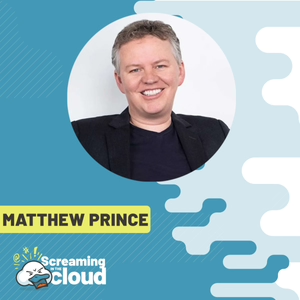
Summer Replay - Cutting Cloud Costs at Cloudflare with Matthew Prince
Screaming in the Cloud
07/30/24 • 45 min
In this Summer Replay of Screaming in the Cloud, Corey is joined by Co-founder and CEO of Cloudflare, Matthew Prince. In this cost-cutting conversation from 2021, Matthew breaks down what exactly Cloudflare is up to, and how they are handling their clients' cloud cost needs. The pair focus on Cloudflare as a company and the options they are bringing to their clients. They discuss their mutual concerns with some AWS costs and why Cloudflare’s suite of tools has slowly been made available over time. Turn back the clock with this fan-favorite episode for more insight.
Show Highlights:
- (0:00) Intro
- (0:53) Backblaze sponsor read
- (1:20) Origins of Cloudflare
- (5:55) The Achilles Heel of the AWS cloud
- (10:09) What is Cloudflare R2?
- (12:26) Pricing philosophies in the cloud
- (17:35) Egress cost of the “static” internet
- (19:48) How Amazon’s pricing harms the overall market
- (24:34) Firefly sponsor read
- (25:10) Cloudflare’s endgame
- (28:32) Staying focused as a business
- (33:35) The value of providing a valuable service
- (37:17) “The internet is a fad.”
- (42:19) The strength of admitting you’re wrong
- (43:04) Where you can find out more about Cloudflare
About Matthew Prince:
Matthew Prince is co-founder and CEO of Cloudflare. Cloudflare’s mission is to help build a better Internet. Today the company runs one of the world's largest networks, which spans more than 200 cities in over 100 countries. Matthew is a World Economic Forum Technology Pioneer, a member of the Council on Foreign Relations, winner of the 2011 Tech Fellow Award, and serves on the Board of Advisors for the Center for Information Technology and Privacy Law. Matthew holds an MBA from Harvard Business School where he was a George F. Baker Scholar and awarded the Dubilier Prize for Entrepreneurship. He is a member of the Illinois Bar, and earned his J.D. from the University of Chicago and B.A. in English Literature and Computer Science from Trinity College. He’s also the co-creator of Project Honey Pot, the largest community of webmasters tracking online fraud and abuse.
Links Referenced:
- The Cloudflare Blog: blogs.cloudflare.com
Sponsors:
- Backblaze: https://www.backblaze.com/
- Firefly: https://www.firefly.ai/
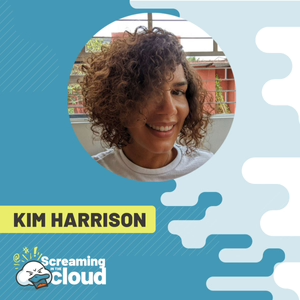
Continuing to Market After the Product Has Sold with Kim Harrison
Screaming in the Cloud
01/18/24 • 32 min
Kim Harrison, a freelance content marketing strategist and author, joins Corey on Screaming in the Cloud to talk about asking the right questions to find your target demographic, why she has such a deep love for story telling, and how marketing extends after the product has been sold. Kim shares her unique experiences with solving urgently painful problems that customers are experiencing and subsequently building a relationship with those customers that allows her to solve more pain points down the line.
About Kim
Kim is a professional storyteller focused on strategic communications. She translates complex ideas into compelling narratives, helping teams share their perspectives. She enjoys building impactful stories, and using a range of mediums and channels to reach specific audiences.
For 10+ years Kim has worked closely with teams focused on big data and developer tooling. They have brought new methodologies forward, impacted the language used to describe technologies, and even established new industry categories.
Links Referenced:
- Personal/Company website: https://www.kimber.kim/
- LinkedIn: https://www.linkedin.com/in/kimberh/
- Twitter: https://twitter.com/kittyriot
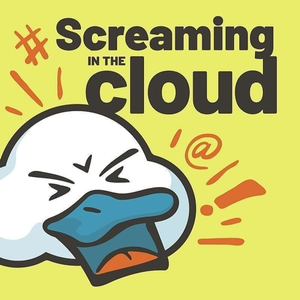
How Tailscale Builds for Users of All Tiers with Maya Kaczorowski
Screaming in the Cloud
12/19/23 • 33 min
Maya Kaczorowski, Chief Product Officer at Tailscale, joins Corey on Screaming in the Cloud to discuss what sets the Tailscale product approach apart, for users of their free tier all the way to enterprise. Maya shares insight on how she evaluates feature requests, and how Tailscale’s unique architecture sets them apart from competitors. Maya and Corey discuss the importance of transparency when building trust in security, as well as Tailscale’s approach to new feature roll-outs and change management.
About Maya
Maya is the Chief Product Officer at Tailscale, providing secure networking for the long tail. She was mostly recently at GitHub in software supply chain security, and previously at Google working on container security, encryption at rest and encryption key management. Prior to Google, she was an Engagement Manager at McKinsey & Company, working in IT security for large enterprises.
Maya completed her Master's in mathematics focusing on cryptography and game theory. She is bilingual in English and French.
Outside of work, Maya is passionate about ice cream, puzzling, running, and reading nonfiction.
Links Referenced:
- Tailscale: https://tailscale.com/
- Tailscale features:
- VS Code extension: https://marketplace.visualstudio.com/items?itemName=tailscale.vscode-tailscale
- Tailscale SSH: https://tailscale.com/kb/1193/tailscale-ssh
- Tailnet lock: https://tailscale.com/kb/1226/tailnet-lock
- Auto updates: https://tailscale.com/kb/1067/update#auto-updates
- ACL tests: https://tailscale.com/kb/1018/acls#tests
- Kubernetes operator: https://tailscale.com/kb/1236/kubernetes-operator
- Log streaming: https://tailscale.com/kb/1255/log-streaming
- Tailscale Security Bulletins: https://tailscale.com/security-bulletins
- Blog post “How Our Free Plan Stays Free:” https://tailscale.com/blog/free-plan
- Tailscale on AWS Marketplace: https://aws.amazon.com/marketplace/pp/prodview-nd5zazsgvu6e6
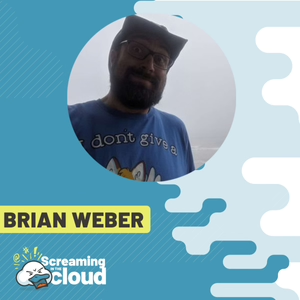
Evolving, Adapting, and Staying Prepared with Brian Weber
Screaming in the Cloud
01/28/25 • 35 min
Ever wondered how Corey got to where he is today? You have Brian Weber to partially thank for that. On this episode of Screaming in the Cloud, Corey catches up with his old friend and mentor to talk about the ever-evolving world of tech. Brian’s been around the block a time or two having done significant stints at Pinterest, Facebook, and Twitter (during the Elon acquisition no less)! As Corey and Brian catch up, you’ll hear them chat about the importance of empathy, coaching the next generation of tech workers, and their conspiracies surrounding Google and Kubernetes. So grab your tinfoil hats, it’s time to go Screaming!
Show Highlights
(0:00) Intro
(0:53) The Duckbill Group sponsor read
(1:27) When Brian took Corey under his win
(3:21) Brian's experience coming to the cloud as an engineer
(7:24) Why it's important to reinvent yourself in tech
(8:54) How Brian reacted to the industry adopting Kubernetes over Mesos Marathon
(10:31) Kubernetes conspiracy theories
(12:30) The importance of empathy in tech
(15:46) Trying to advise younger generations entering tech
(19:19) The Duckbill Group sponsor read
(20:02) Working at Twitter when jobs started getting cut and the site frequently went down
(22:41) The best way to navigate certification expiration
(26:08) Talking about "The Golden Path”
(28:52) Why you should always plan ahead in tech (and life)
(34:21) Where you can find more from Brian
About Brian Weber
Brian is a former FedRAMP DevOps Engineer for Coralogix. He’s also been a Site Reliability Engineer at Twitter, Pinterest, and Facebook, where he has maintained large installations on-premises, building reliability, security, and developer efficiency. In my spare time, Brian skis, knits, cycles, bakes, and tries to spend as much time outdoors as possible.
Links
- Brian’s LinkedIn: https://www.linkedin.com/in/brian-weber-2423b55/
Sponsor
The Duckbill Group: duckbillgroup.com
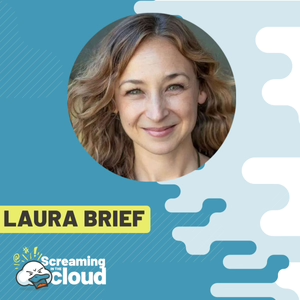
Learning the Joys of Reading and Writing with Laura Brief
Screaming in the Cloud
11/14/24 • 38 min
Before cloud economics entered his life, Corey’s first true love was a good book. On this episode of Screaming in the Cloud, he’s joined by Laura Brief, the CEO of nonprofit 826 National. The organization is the largest youth writing network in the country, something that’s near and dear to our hearts at The Duckbill Group. Corey and Laura talk about why having a deep appreciation for reading and writing is vital no matter what career path you take. From offering a creative escape for kids to moonlighting as a “pirate supply company,” 826 National helps children realize that there’s an author inside all of us. So check out this great conversation, and be sure to buy one of our shirts while you’re at it!
Show Highlights
(0:00) Introduction
(1:02) Gitpod sponsor read
(2:14) The Duckbill Group's history working with 826 National
(3:01) What is 826 National?
(4:43) Corey's love of reading, writing, and how it correlates with 826 National's mission
(10:11) The rise of ChatGPT and its impact on reading and writing
(13:49) Why GenAI fails to capture the feeling of writing
(22:30) Why writing education is important
(24:54) The benefits of reading and writing for kids
(31:39) 826 Valencia: the Pirate Supply Company
(35:24) Buy a shirt benefiting 826 National!
(37:15) Where you can find more from Laura Brief and 826 National
About Laura Brief
Laura Brief is the CEO of 826 National. Prior to joining the nonprofit, Laura held leadership positions at high achieving youth organizations including Build, First Graduate, Juma Ventures, and The Posse Foundation, where she developed the organization’s first national career, corporate engagement, and alumni programs. She holds a Master’s in Education and a Master’s in Counseling Psychology from Columbia University, and is the Chair of the Board of Directors at Youth Speaks.
Links
- 826 National: https://826national.org/
- Reach out to Laura: [email protected]
- Buy our charity shirt to help support 826 National: shitposting.fashion
Sponsor
Gitpod: gitpod.io

Episode 4: It's a Data Lake, not a Data Public Swimming Pool
Screaming in the Cloud
04/04/18 • 34 min
Open source activism tends to focus on running on hardware you can trust and avoiding Cloud computing. The problem with some Cloud providers has to do with a conflict of interest between serving customers and how they generate revenue. It’s important for the customer to have control of their computer and their data in the Cloud. But what about their security and privacy?
Today, we’re talking to Kyle Rankin, chief security officer at Purism and writer for Linux Journal. He is a Linux expert who decided to work at Purism because of the company’s belief in free software and the Linux community.
Some of the highlights of the show include:
- Cloud providers have faced challenges when it comes to data privacy and who owns what.
- The word “Cloud” is overloaded, and it is unclear who is in control.
- Cloud providers can sabotage efforts to make programs work together.
- Cloud providers may not troll through data and exploit it. Yet, they develop tools for customers to be able to do that.
- Even though Linux Journal stopped being printed and went digital, and was going under, it’s now back and taking a new approach.
- What matters to new readers and Linux users is now different than what was important to original readers.
- The more time you can spend to understand what’s happening behind the scenes will make you much more marketable and adaptable.
- Kyle explains whether Amazon Linux is becoming a viable concern and if distribution matters anymore. Now, it’s about running an application, not thinking about what it’s running on.
- Are there gangs of Cloud users? Do people look down on Azure users? The target is always moving and changing.
- Check out Kyle’s book, Linux Hardening in Hostile Networks: Server Security from TLS to Tor.
Links:
- Kyle Rankin on Twitter
- Purism
- Kyle Rankin’s book - Linux Hardening in Hostile Networks: Server Security from TLS to Tor
- Linux Journal 2.0 FAQ
- GorillaStack (use “screaming” for discount)
Show more best episodes

Show more best episodes
FAQ
How many episodes does Screaming in the Cloud have?
Screaming in the Cloud currently has 643 episodes available.
What topics does Screaming in the Cloud cover?
The podcast is about Cloud, Aws, Devops, Podcasts, Technology, Business, Amazon and Careers.
What is the most popular episode on Screaming in the Cloud?
The episode title 'Learning Tech in Public with Ceora Ford' is the most popular.
What is the average episode length on Screaming in the Cloud?
The average episode length on Screaming in the Cloud is 36 minutes.
How often are episodes of Screaming in the Cloud released?
Episodes of Screaming in the Cloud are typically released every 5 days.
When was the first episode of Screaming in the Cloud?
The first episode of Screaming in the Cloud was released on Mar 19, 2018.
Show more FAQ

Show more FAQ